Release the
piston
Magnus Karlsson
Boras, Sweden
492karlsson@telia.com
Edited by Reid Trummel
Stuck pistons in the
brake calipers can sometimes become really stuck. The normal method to
"unstuck" them is to blow compressed air into either one of the holes for
the bleed nipple or into the brake pipe nipple. To do this, first make
sure that the other hole (the bleed nipple or the brake pipe nipple, whichever
one you're not using to blow in the compressed air) is blocked. Then insert
a piece of wood between the pistons in order to dampen the impact when
the piston releases.
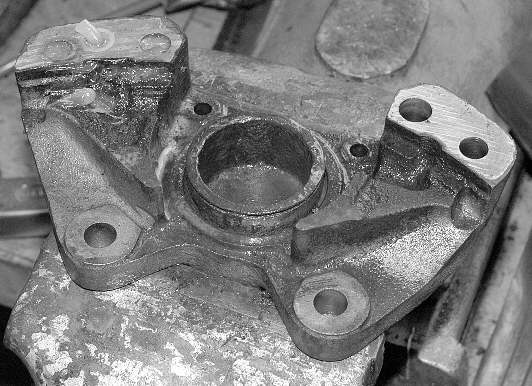
Piston that wouldn´t
let go eventhough grease was used through the bleed nipple hole.
If the compressed air
method is not successful, try the grease gun method. It works along the
same principles, but you fit a pointed end to your grease gun and hold
that pointed end very tight to one of the brake fluid holes in the caliper.
This method will exert a much higher pressure on the pistons than the compressed
air method will. However, if the pistons really are stuck, chances are
that you will not beable to keep the pointed end firmly enough against
the hole and thus the grease will leak out.
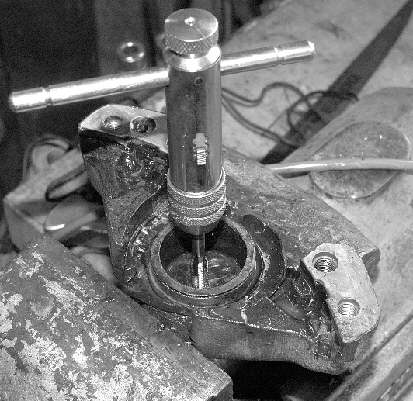
Tapping a hole in the
piston in order to fit a grease nipple.
Now is the time to become
"radical." First you split the calipers. This is something that many people
are afraid to do since it is stated in Girling manuals that this is strictly
forbidden. However, Girling gives no reason as to why this practice should
be avoided. I cannot take any responsibility for what can happen if someone
reads this article and decides to split his calipers, but I can say that
I have done it with many calipers and never had a problem. Myself, I prefer
this practice to scrapping calipers with stuck pistons. It also gives one
the opportunity to change the seal between the caliper halves, the condition
of which can leave a lot to be desired after 40+ years. It is important
to use a rectangular-section O-ring (flat, like metal washer) for this
as it has been manufactured to function in a brake fluid environment. An
ordinary O-ring (with a round section) may not be compatible with brake
fluid, since most of them are manufactured to function only with oil and
gas.
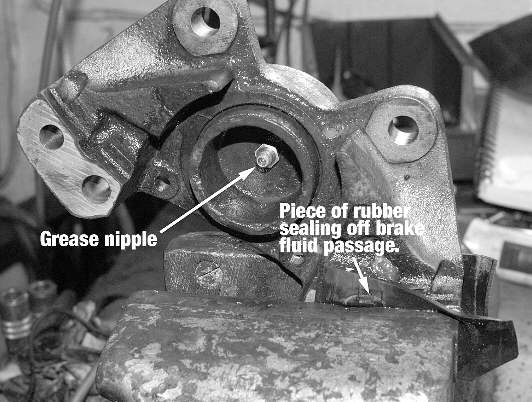 After your calipers are
split, you next drill a hole through the piston with a suitable diameter
drill, so that the hole can be tapped to fit a grease nipple (see photo).
Then you block off the brake fluid passage by clamping the caliper half
in a vice with a piece of rubber mat covering the passage. One of the caliper
halves is easy to clamp in the vice. In order to clamp the other half you
must use two of the caliper bolts as seen in the photo.
After your calipers are
split, you next drill a hole through the piston with a suitable diameter
drill, so that the hole can be tapped to fit a grease nipple (see photo).
Then you block off the brake fluid passage by clamping the caliper half
in a vice with a piece of rubber mat covering the passage. One of the caliper
halves is easy to clamp in the vice. In order to clamp the other half you
must use two of the caliper bolts as seen in the photo.
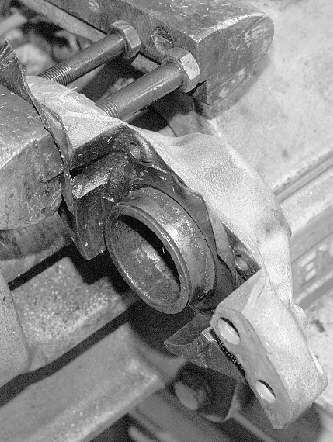
Caliper bolts used
so that the caliper half can be clamped in the vise.
Then attach your grease
gun to the nipple and start pumping it. You will find that the stuck piston
comes out very easily and in a very controlled way. I have yet to experience
a piston that will not release when subjected to this treatment.
After completing this
operation you will of course have to replace the pistons, the seals and
the dust seals. I recommend that you fit stainless pistons as they are
available for both types of calipers used on Healeys.
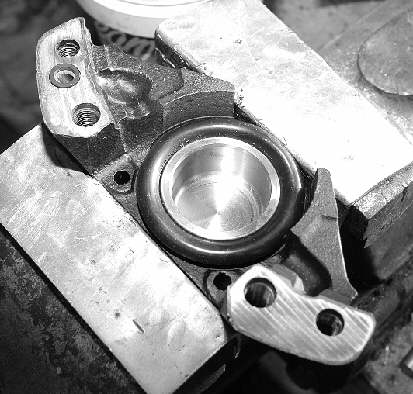
Restored caliper half
fitted with new seals and stainless piston. Please observe the correct
square section O-ring, top left corner.
home





